#Basaltic Hill
Explore tagged Tumblr posts
Text
Cave Hill, Belfast
Cave Hill, or Cavehill, is a basaltic hill overlooking the city of Belfast. It forms part of the southeastern border of the Antrim Plateau. It is distinguished by its famous ‘Napoleon’s Nose’, a basaltic outcrop which resembles the profile of the famous emperor Napoleon. Cavehill is also the name of an electoral ward in Belfast. Historically it was known as Ben Madigan, which is derived from the…
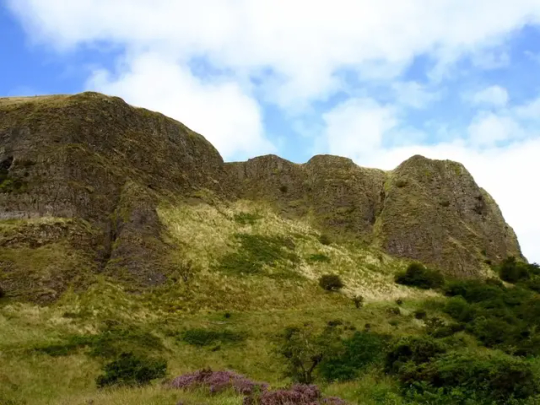
View On WordPress
#Antrim Plateau#Basaltic Hill#Belfast#Cave Hill#Cavehill#Co. Antrim#Gullivar&039;s Travel#Ireland#Irish History#Jonathan Swift#Napolean#Photography#Sleeping Giant
6 notes
·
View notes
Text
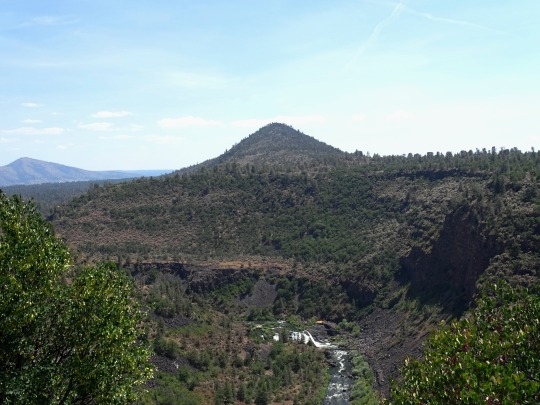
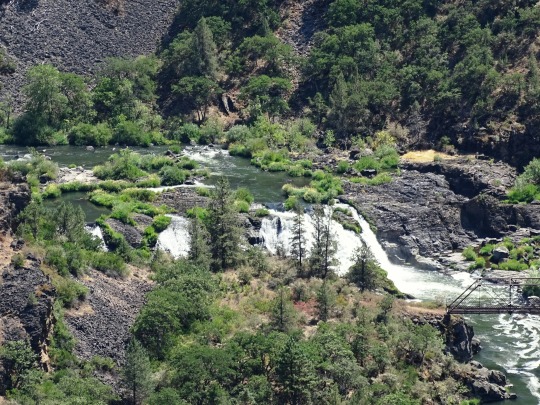
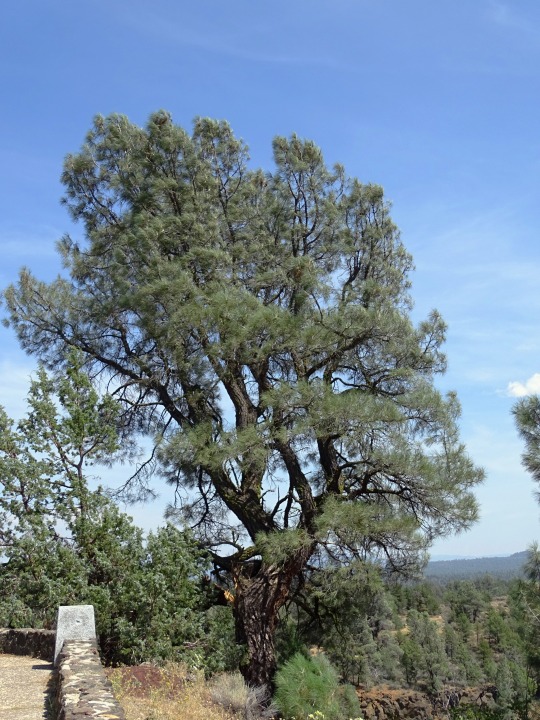
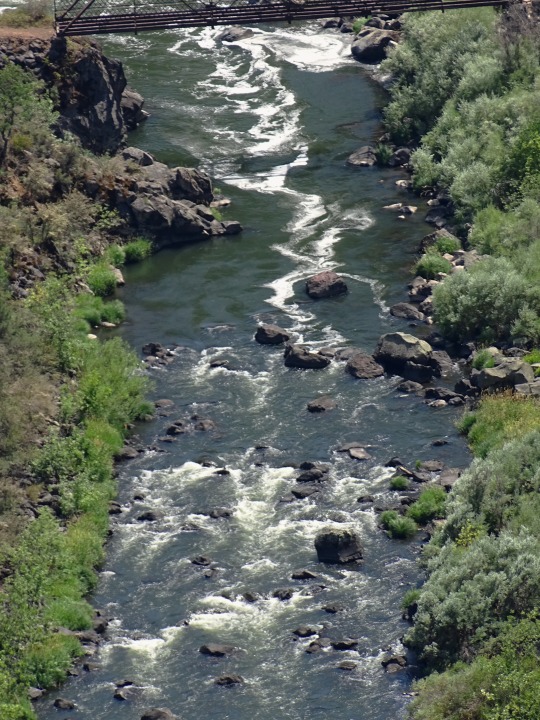
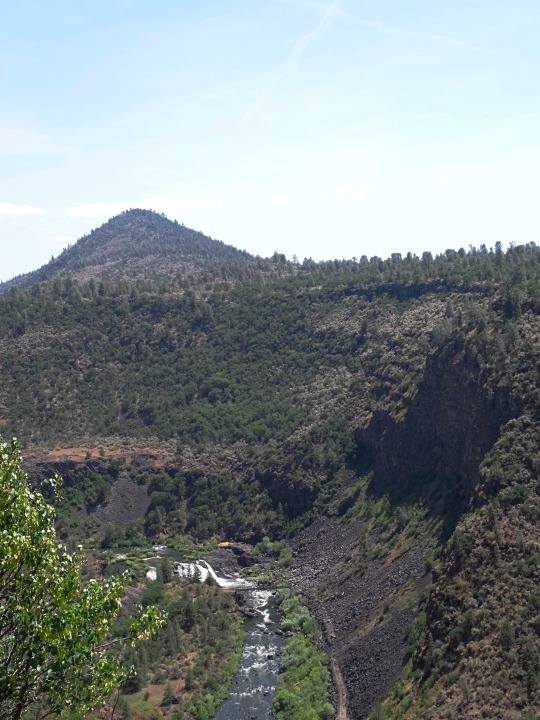
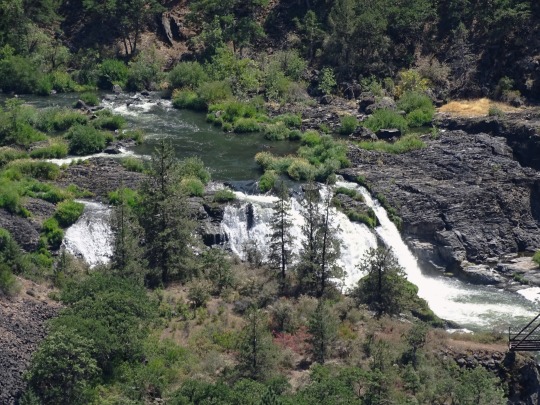
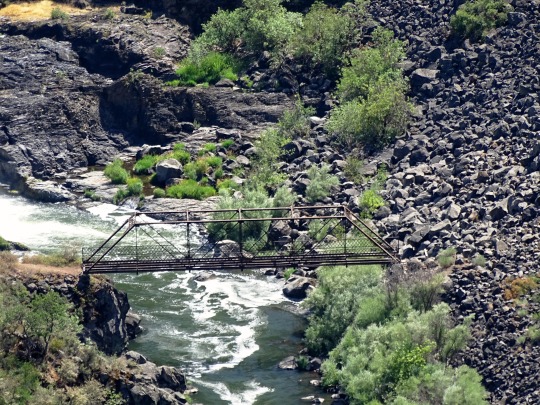
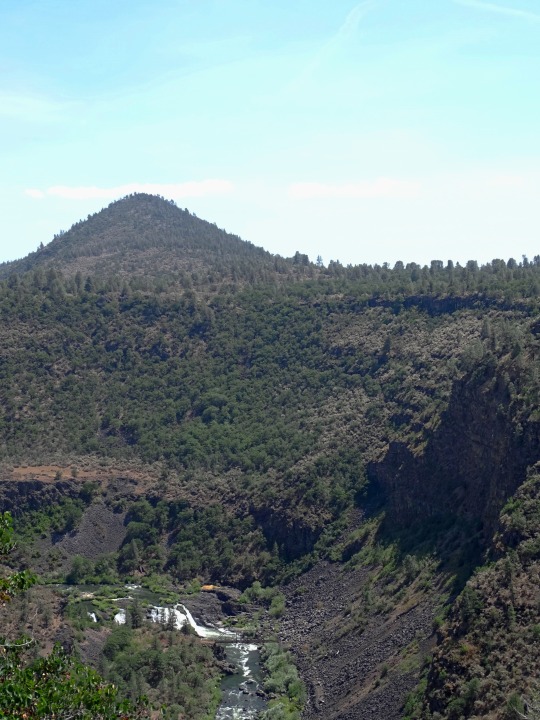
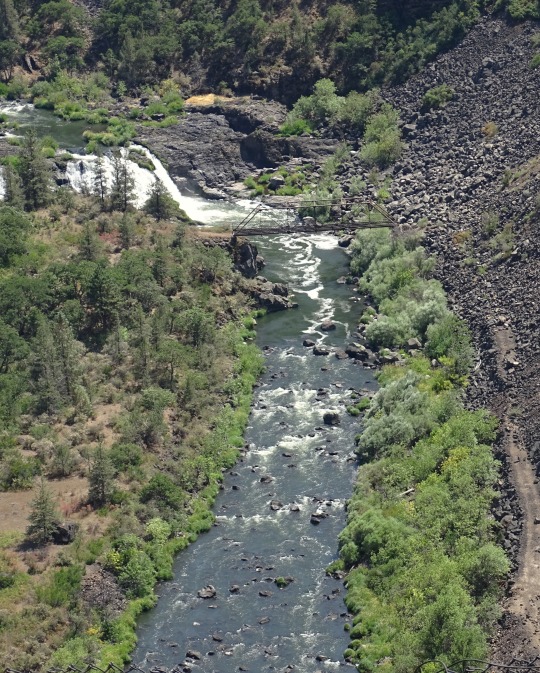
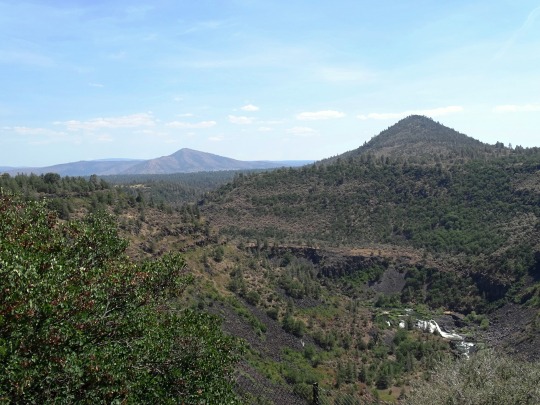
Pit River Falls, CA (No. 1)
The Pit River is a major river draining from northeastern California into the state's Central Valley. The Pit, the Klamath and the Columbia are the only three rivers in the U.S. that cross the Cascade Range.
The longest tributary of the Sacramento River, it contributes as much as eighty percent of their combined water volume into the Shasta Lake reservoir; the junction of their Shasta Lake arms is 4 miles (6.4 km) northeast of Shasta Dam. The main stem of the Pit River is 207 miles (333 km) long, and some water in the system flows 265 miles (426 km) to the Sacramento River measuring from the Pit River's longest source.
The Pit River drains a sparsely populated volcanic highlands area in Modoc County's Warner Mountains, passing through the south end of the Cascade Range in a deep canyon northeast of Redding. The river is so named because of the semi-subterranean permanent winter homes and large 'sweat houses' that the Pit River Tribe dug, and their pit traps for game that came to water at the river.
The river is a popular destination for fishing, fly fishing, and rafting in its lower reaches, and is used to generate hydroelectricity in the powerhouses below Fall River Mills where the Pit and Fall rivers join, and at Shasta Dam. It is also used extensively for irrigation and conservation purposes.
Source: Wikipedia
#Pit River Falls And Canyon Vista Point#Pit River Falls#Fall River Mills#Shasta County#California#flora#travel#original photography#vacation#tourist attraction#landmark#landscape#nature#USA#summer 2023#hills#forest#woods#fir#tree#Pit River Canyon#Pit River#waterfall#basalt riverbed#volcanic plateau
32 notes
·
View notes
Text
what i've learned from philosophy is that you can actually milk a stone if you understand that it is the only way to be truly happy
#untitled.txt#''milking a stone'' is ''learning to love things you do daily that you don't currently''#you have to push that rock up the hill every day and maybe the best way to do that is to love the rocks you push!#imagine your chores are hexagonal basalt columns and everything gets 10x easier#that's it i've won philosophy#(1 am moment)
0 notes
Text
Wordplay Wednesday: Unconformities

Unconformity is a word used quite often by geologists. This is in reference to a contact between rocks that are unconformable or that were not deposited in sequence. There are several types of unconformities. Take the one above that I took at John Day Fossil Beds. The pale strata at the bottom of the hills are the fossil bearing John Day Formation from the Eocene/Oligocene (56-23.03 Ma). This is primarily welded tuff and tuffaceous siltstones. The dark strata above that is the Miocene Columbia River Basalts.

There is a distinct erosional surface between the two layers. This is called a disconformity. A disconformity is an unconformity between parallel layers of sedimentary rocks which represents a period of erosion or non-deposition.
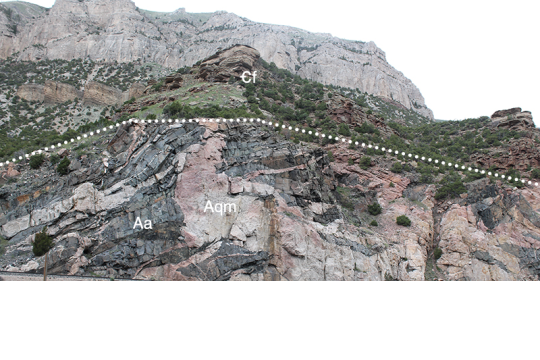
In the Wind River Gorge in Wyoming, there is another kind of unconformity called a nonconformity. A nonconformity occurs when sedimentary rocks are deposited on top of igneous or metamorphic rocks that have been eroded. In the above photograph, Cambrian Flathead Sandstone was deposited on top of eroded Archean granite.
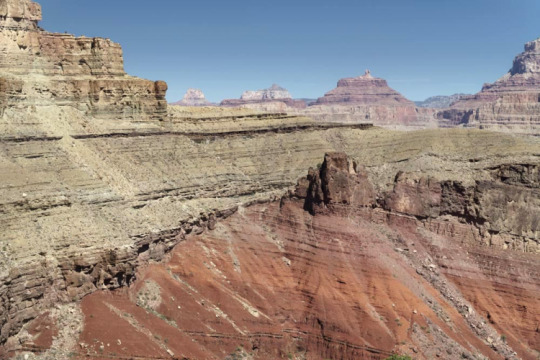
Perhaps you have heard of the Great Unconformity in the Grand Canyon? It's pretty famous even by non-geologists. It is the final kind of unconformity, the angular unconformity. An angular unconformity is a gap in the geologic record where tilted, eroded rock layers are overlain by younger, horizontal layers of sedimentary rock.

In review:
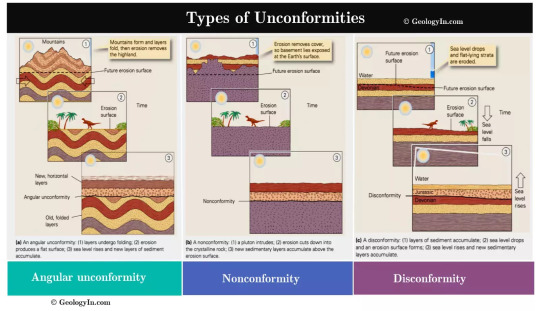
Tune in tomorrow for a look at the father of paleontology and make sure you remember today's terminology. It will be important for next Tuesday! Fossilize you later!

#fun facts#geology#science#science education#unconformity#disconformity#angular unconformity#nonconformity#john day fossil beds#grand canyon#wind river gorge
64 notes
·
View notes
Text
Book of Lost Tales 5: more houses of the Valar!
Writing on my phone, so there might be hilarious autocorrect mistakes. Long post.
Oromë is often outside Valinor, more often than Ossë and as often as Yavanna. But he's got a lot of land full of forests and mountains and deer and bison (!) and all kinds of animals, which he doesn't hunt, because he only hunts outside of Aman. Also, there are no predators. I guess Manwë's eagles eat grass? Ok maybe there are predators, just not in those forests.
Oromë's house is wide and low, full of trophies and hunting weapons. I imagine a log cabin the size of a palce. In the middle of each room there's a living tree used as a column, which is really cool. The color scheme is, predictably, green and brown. I really need to find time for Minecraft again. Also, there's partying.
Vána spends most time in her gardens, fenced with huge whitethorns (hawthorns, but with a pretty name) and the center is full of roses and her favorite place. And in there is the cauldron of golden light and a fountain of it.
Birds sang there all the year with the full throat of spring, and flowers grew in a riot of blossom and of glorious life.
I love the prose. Also:
So fair were these abodes and so great the brilliance of the trees of Valinor that Vefántur and Fui his wife of tears might not endure to stay there long, but fared away far to the northward of those regions,
(those are Mandos and evil!Nienna in case you forgot)
So they begged(!) Aulë to carve then a house under the roots of cold northern mountains. So he did, with the help of their (we don't call them Maiar yet) who are called "shadowy folk" which doesn't sound like they're nice people. They dug vast caves that go even under the sea, and are gloomy and eerie, and this is the Halls of Mandos. But here the place is called after the Vala, not the other way around.
His main hall is black (of course Tolkien can't simply say "black", it's "sable" because this sounds more ominous, just like with Morgoth's shield). It is full of dark mist, illuminated with one small lamp with a few drops of the silver dew. The floor and columns are made of jet (mmm nice, I'll use blackstone probably when doing it in Minecraft). Do you think it's peak goth vibes? No. Just wait.
Anyway dead Elves land there, and btw they can die only by getting killed with weapons, or of grief. Hunger, cold etc aren't lethal to them? Probably? Anyway then Mandos judges them and they wait for an appointed time in dreams of memories (no mention of torture or general unpleasantness, it's just gloomy) and are reborn. In their descendants.
And now we get to Fui, and it's... A lot.
She's the wife of Mandos, her job is "the distilling of salt humors whereof are tears", and black, weblike(!) clouds of "despair and hopeless mourning (!!), sorrows and blind grief".
She's basically uNienna with a touch of Ungoliant... But that's not all.
Her hall is bigger and darker than her husband's, and lit with a single coal. The walls and pillars are basalt and the roof is made of bats' wings. This is peak goth interior design.
Oh, and she judges the Men after they die (!?!) and now it gets funny, because the part about Men leaving Arda went away for a holiday, and in this chapter they get a in-Arda afterlife, which is a mix of various mythologies.
Some stay in Mandos, which is the most normal thing.
some she drives forth beyond the hills and Melko sizes then and bears then to Angamandi, or the Hells of Iron, where they have evil days.
Ok. So.
The Valar actually, officially send some spirits of Men to Melko, because, idk, justice? I wonder if he ever thanks Fui for that.
Generally, in BoLT Melko seems much more... Accepted? Fitting into the world? I'm not sure how to call it. More in place there.
Fui is scary and I hate her. Well ok, I don't hate her more than Melko... No, wait. I do. Sorry. Characters whose evil is not acknowledged by the narrative get a different treatment. 😠
I love the phrase "they have evil days"
So, back to the afterlife mess for Men. Some are send in a black ship with black sable sails to plains from which a little bit of Taniquetil is visible, and I think this is meant to be the winning option???!?!? They camp there and sung a little bit and wait for the end of the world.
Ok, there's another, better option: some lucky few are brought by proto-Eonwë to Valmar and party with the Valar. And wait for the end of the world.
As I said, this thing is a mess.
Makar and Meásse build their own house without Aulë (why? It's not said why. I guess they didn't like him), sided only by their we-don't-call-them-Maiar-yet.
It's grim, and made of iron and full of noise and fighting and booze. No Valar visit then except Tulkas, who doesn't like them (or them him), but he needs to keep fit.
Their house is full of weapons and shields, and lit with torches, and we get a mention of red torchlight reflected in naked swords, which I suppose Tolkien liked, because we'll get one in the film too, at the oath of Feanor.
And that's it, now for the chapter notes.
So, Christopher Tolkien days that Elves dying only from wounds or grief is canon even in the Silm. (This would explain why Maglor throwing himself into the sea did not work, also makes him look somewhat stupid 😁 but it's rather have Maglor stupid and alive than dead.)
#tw suicide mention#kinda#well maglor did try... in my hc at least...#anyway#eri reads the legendarium#bolt#silm#book of lost tales#silmarillion#Tolkien legendarium#the silm#the silmarillion#bolt read-through#valar#valinor
26 notes
·
View notes
Text

Basalt colonnade, Szent György-hill, 1906. From the Budapest municipal photography company archive.
102 notes
·
View notes
Text
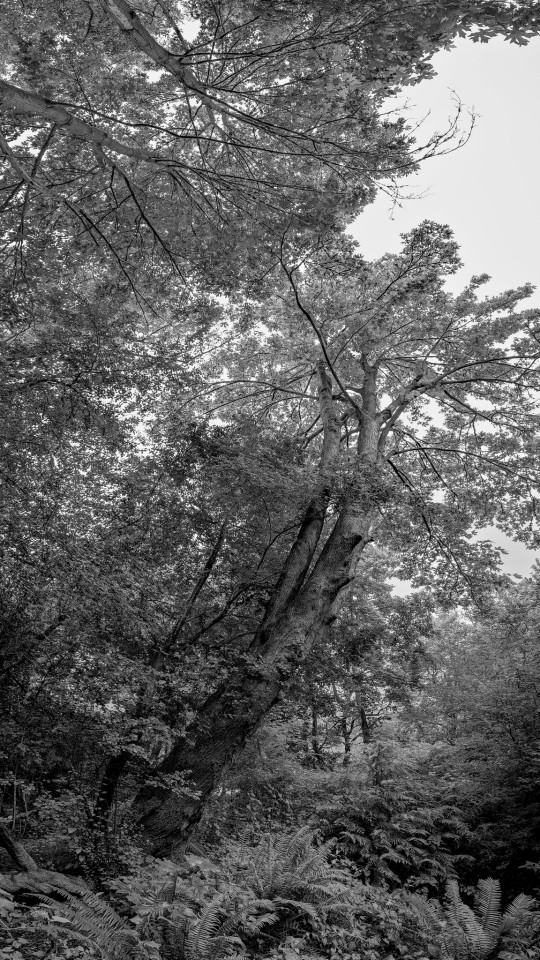
Unsettling Sound The Puget Sound is an unsettled sea that lies above the tectonically active western edge of the North American Plate. This large body of frigid water is separated from the Pacific Ocean by the Olympic Mountains to its west and the Cascades to its east. Glaciers crowded into the Sound during the last ice age, advancing from the north. When they retreated some 13,000 years ago they left behind deep deposits of interglacial sediment. These sand and clay remnants, in turn, were carved by frequent rain, sea and wind erosion to form high, unstable coastal bluffs, which were soon blanketed by dense evergreen overgrowths of cedar, hemlock and fir, and undergrowths of alder, blackberry and fern. As erosion progresses this cover slides from high bluffs in slow cascades that often take decades to complete from hilltop to shore. The process is sped up when the northwest rains are heaviest. Landslides can carry trees and their understory to the beach in an instant. Once arrived on the shore, the upended forest enters the marine ecosystem, where it functions as nutrient, shelter and barrier. In the last centuries, human structures have been added to this tumult. Houses perched on bluffs afford spectacular views and command high prices, but they face the disturbing prospect of being splayed across the beach following a prolonged downpour. Slides in the Northwest earn frequent headlines, and were even the subject of a popular book and film set on the slopes of Queen Anne Hill. Much hilltop construction in the area occurs with little immediate awareness of the role erosion plays in maintaining both the geological and biological integrity of the Sound. A common response to the inevitable is to line the bank with black basaltic stones quarried from ancient lava beds. The proliferation of these bulkheads throughout the Puget Sound has resulted in a phenomenon called “shoreline hardening.” According to some government statistics, approximately 30 percent of the Sound’s shoreline is now armored with stone and concrete reinforcements. This happened along the beach where my family has lived for nearly a century. in the 1970s and 80s, property owners piled stone bulkheads to shore up against sliding —attempting to fix in time something that’s always in flux. The results of our obstinance has been devastating. Within years this beach began to lose much of its value. As a child, I can remember clawing a hundred Native Littlenecks from the sand and clay beneath beach rocks. We let these clams sit for a couple of hours in a bucket of seawater. My grandparents taught us to sprinkle in cornmeal so they could spit out stomach sand as they fed. Once full, they were transferred into a steaming pot where they open latticed shells to offer up their tenderness. Today I’m lucky if I find a single Littleneck after 30 minutes of raking. When I visit the Sound, I think of Sue and Payne, who were privileged to live on this shore and loved what it could yield to any of their grandchildren willing to put some time into it. They left us more than 20 years ago, and a new generation of family has built modern homes on the foundations of those Sue and Payne left behind. In time, ownership may be handed to successive generations, or we might drift away, passing the beachfront to someone with no memory of what it meant to a family that gathered there. And while the Sound may retain much of its scenic beauty, this too is fleeting. The tides will rise and fall revealing stretches of rocks and sand, again and again, and still something will always remain unsettled until it’s gone.
#timothy karr#documentary photography#landscape photography#witness#and words#cellphone photography#cellphone composite
132 notes
·
View notes
Text
Flight Rising flights but as art mediums:
There are some overlaps in mediums since dragons are so tight knit and far spread
Earth: tile work/mosaics, jewelry work, ceramics, stone sculpture, chalk, clay work, plaster, leather work, rain chains
Water: plaster work, woven tapestries, shell jewelry and chimes, pearl inlays, decorative sails and flags, basket weaving, sandstone carving, watercolors, mirrors and glass sculptures
Shadow: optical illusions, black and white photography, puzzle boxes, uranium glass work, maybe iron work, mycology arrangements, shadow boxes, gouache, anything that involves glowing in the dark
Light: stone carving and gold foiled painting, sometimes tapestry weaving to depict an image or scene, impressionism, oil paint, tempera, portraiture, clothing and attire, mirrors, pigment making
Plague: hyper realism, and taxidermy, ceramics, bone carvings, tattoos, ink block prints, collage art, murals, leather work, totems and large outdoor installations
Nature: floral arrangements, dye work, wood work, candle making, hot wax painting, landscaping, rain chains, wind chimes, tapestries, needle felting, carpentry, animal cosmetics (haircuts, animal safe dye, nail and claw painting, etc), apparel/clothing, pigment making
Ice: needle felting, wood carving, quilting, ice carving and sculpture, snow sculptures, knitting, the art of tea blends, dried plant arrangements, carpentry, fabric weaving, tapestries, crochet, wood burning, blanket weaving, candle making, dye work, wood turning
Fire: welding, decorative weapon smithing, glass blowing, wood burning, wrought iron, stained glass, latticed metal, terracotta, ceramics, obsidian and basalt carving, graphite, slate, charcoal
Wind: paper mache, ribbon mediums, basket weaving, sonorous sculptures, wind chimes, feathered attire, really tall and thin structures/sculptures, jade carving, blanket weaving
Arcane: resin, stained glass, welding, intricate silver work, collaborative neon work with shadow (they need that special eye for glow in the dark), crystal carving, zen gardens, bonsai art, screen printing, photography, illuminated manuscripts, clothing and apparel, gold foil work, abstract art
Lightning: bronze cast sculptures, sand sculptures (when lightning strikes the sand and turns it to stone) aluminum casts poured into ant colonies/hills, pop art, up-cycled art, photography, art that is still capable of being utilized and interacted with because people and dragons are part of the medium, assemblage art, banners and flags
#feel free to add your own this is all I could think of off the top of my head#you are also free to use this for lore purposes I’m just spit alling ideas#I understand music and writing are also artistic mediums but I was thinking tangible mediums#plus mysic and writing have their own categories and genres#fr#dragon#flight rising#flightrising#flight rising flights#flights#worldbuilding
176 notes
·
View notes
Text
Captain Scarlet and the Singing Squadron - Chapter 4: Scarlet vs Black, part 1
(Prologue, Chapter 1, Chapter 2 -p1, Chapter -p2, Chapter 3, …)
I am back with a new chapter! >:D
@uniwolfcorn @teapotteringabout @skymaiden32 @knyee @janetm74 @the-original-sineater @thundergeek59 @riallasheng @mariashades @yarol2075 @voidparadoxical @llamawrites @river-sam2 @coco9728 @hebuiltfive @thalassastra @bassic-ally @pareidoliaonthemove @graverinth
-0-0-0-
The Angels had landed on the mini airport near the station. Giving their Fighters a much needed refuel.
Destiny, Rhapsody, and Harmony were helping the captains planning how to counter the Mysteronized Jets when they do suddenly appear. And where to start searching for Captain Scarlet.
Rhapsody was obviously the most worried of them all. The British Angel biting the nail of her thumb, while trying to distract herself by focusing, maybe a little too hard, on the mystery at hand.
To think that later, she and Scarlet would go on a date on the Kuril Islands. Adam would bet they would spend a much-needed time in the hot springs and enjoy the sight of the beautiful basalt formations, the black volcanic sand, and the white pumice hills.
Destiny, the French lead squadron pilot, gently calmed her teammate. She too was worried of the situation. But keep a firm mental support among her peers to formulate a plan in case something worse happen.
Harmony had a frown on her round, usually calm and soft Asian face, which told of many promises of a nasty punishment. Everyone knew if she had found the culprit responsible for capturing Scarlet, somebody would become a bloody pulp on the floor.
Not that she would necessarily attack on sight, but it was a well-known fact if said culprit turned out to be a prick.
Speaking of culprit…
“Do you think… the person who took Scarlet might have to do with those rumors?” asked suddenly Rhapsody.
“Huh, I didn’t put it that way…” Captain Ochre rubbed his chin, then raised a brow at the British Angel, “What makes you think these two are connected?”
“If you think about it: the crew of this powerplant mentioned about the recent happenings in the forest nearby. Which they claimed this didn’t happened until last night,” she began, walking around the table as her finger lightly dragged across the map, “Then, the Mysteronized fighter jet we fought early got mysteriously shot down, and Scarlet was taken after the crash.”
“Which means, something - or someone - was in that forest doing the Scooby-Doo levels of weird things,” Ochre concluded.
Rhapsody pursed her lips from laughing, as she nodded.

“Well, let’s not forget the lads here also mentioned about this place once being a great battlefield a century ago,” Magenta pointed out. Though, nobody missed his eyes filled with discomfort.
“Pat, don’t tell me you believe in ghosts?” Harmony smirked with amusement.
“I hope I don’t have to…” he tried to hide a gulp.
“Alor! Are we already going over these stupid things?” Destiny laid her knuckles on her hips, giving everyone a serious stare.
Before anyone could say anything, Captain Blue’s epaulets began flashing white.
Blue took his cap and placed it on his head, letting the mic flip from his cap’s visor to his mouth.
“Colonel White, sir?” he listens in attention.
“Captain Blue. Lieutenant Green and I had managed to locate Captain Scarlet,” his commanding officer replayed the news.
Everyone sighed in relief. Rhapsody especially lay her hand to her heart. In which Adam slightly smiled at her reaction.
“Yes sir! Can you tell us where he is?” he asked, ready to pick up his equipment.
“Now hold on a minute, captain,” the colonel spoke firmly, “There’s something I need to tell you about the supposed condition of Scarlet. During our call, there were moments where he appeared to be acting strangely.”
Everyone shared looks as they began to worry once more. Colonel White continued.
“He claimed he was alright, but one time he seemed to have whispered something… or whispered to someone. There were pauses to some of my questions. And he had also claimed that he was ‘not alone’. Would you go and check on him if he’s mentally stable? I’ll send the coordinates immediately,”
“S.I.G”
Cutting off the comms, and the mic flipped back into place, Blue looked at every officer.
“So, uh… who’s coming with me?” he smirked.
-0-0-0-
Seems oddly calm for a birch forest, thought Captain Blue as he and his group trekked about the outskirts.
“I don’t like this…” Rhapsody muttered. Her eyes were glancing left and right with wary, “This place is giving me the creeps.”
Captain Ochre, who was right behind them, holding the Mysteron Detector in his hands, threw a sharp glance at the darkest parts of the forest. And shivered by the sudden cold of the silly imaginations his mind had conjured up, in which, thanks to his training, immediately suppressed them.
“Fishy… like we’re about to go ‘fish out of water’,” he slightly joked.
The two of them turned around to him, giving him sarcastic raised eyebrows in which he grinned back at them with innocent eyes.
“Looking for your colleague?” a voice echoed from elsewhere.
Everyone sharply turned towards the source of the voice. Standing before the bushes, was a young man holding a dog.
He was pretty tall for a youngster, almost as tall as Captain Blue. But him wearing a perfect copy of the century-old military outfit from the Eastern Front, with the badges and all, made this encounter all the more bizarre!
As far as everyone know, there was no reports of a movie being filmed here.
To not let the young man, wait, or grow wary of them, they step in to play along.
“Yeah, kid. We are looking for our buddy, Captain Scarlet. Did you happen to see him?” Blue finally asked.
“Da! He’s at our camp. Just a few minutes away,” the young man pointed somewhere forward along the edge of the forest.
Meanwhile, Captain Ochre took a shot of the fella with the Mysteron Detector. The Polaroid-like picture was being produced, supposed to show an X-Ray image of the person.
If the person was a human, the picture would appear normal with visible bones. If they were a Mysteron Agent, it would come out as clear full picture of the face. Like they were null to the rays.
The picture of the man came out as none of those things; instead, it showed a big black blob.
Ochre retried again, turning the detector off and on to check if there was a mistake.
The pictures still showed the same results.
The trio threw a glance at each other before turning their eyes back at the young man in front of them.
“Say, what’s your name?” Ochre nodded his head towards him.
“Grasshopper,” the man replied.
“Grasshopper?” Blue raised his eyebrows. While the calmest of the captains held his breath from giggling, his eyes were glittering with mirth.
Rhapsody merely covered her mouth with her hand while Ochre didn’t manage to hold out a laugh, let alone a giggle.
“That’s my callsign…” Grasshopper deadpanned sarcastically.
“Got it!” Blue waved his hand, shaking his head a bit to recompose himself “Well? Are you going to lead us to our colleague?”
The young man threw a hand towards the passage.
“Prashou!” he said with a smile.
#my fanfics#captain scarlet#captain scarlet and the mysterons#only old men are going into battle#Captain Scarlet and the Singing Squadron#ga fanfiction#crossover fanfiction#gerry anderson
20 notes
·
View notes
Text




Some Ponniyin Selvan themed tarot card designs! In no particular order. And there will be more!
Some design notes under cut
The Fool : Chose Vandiyadevan for this one. The Fool Card I referenced had a dog in it and I chose to replace that with Semba. Instead of a traveller's bindle, Vandiyadevan here is holden a sheathed sword, symbolic of Aditha Karikalan's sword he received in the beginning of the story. Instead of snowy mountains, around him are green Nilgiri Hills and black basalt rocks, typical for the Deccan plateau.
The Magician: Chose Ravidasan for this. My train of thought was essentially = Sorcerer? Magician? Kinda?. Kept the left hand pose same as the original card but replaced the white wand with the fire in hand which is how the PS movies portrayed Ravidasan praying to Kottravai (I haven't read the books). Chose not to draw anything else from the original card, since it didn't fit Ravidasan's aesthetic and I also kinda liked the look of the card without anything 🤷♀️
The Hierophant: This one's Madhurantakan. It just fits him so well! My intention with this was to draw him sitting on a throne in a Chola style Shiva temple, but I found it more appealing to have a blurry/dark background with the lighting on Madhurantakan himself, which ended up making the background details kinda pointless. The two people kneeling are supposed to be Periya Pazhuvettaraiyar and his brother, though honestly, interpret it how you will. Original card ref.
The Hermit : Chose Alwarkadiyan Nambi for this. Replaced the lamp from the original card with one of those deepams that have a deity at the center and are throne shaped. The one my mom owns/ the ref I had in mind has Vishnu at the center so it sorta felt fitting, at least on a personal note. He's supposed to be standing on a beach but unsure if that's coming across (I'm not that great with backgrounds....)
#ponniyin selvan#ps 1#ps 2#ponniyin selvan 2#ps tarot deck#madhurantakan#vandiyathevan#vandiyadevan#vallavaraiyan vandiyadevan#alwarkadiyan nambi#tarot cards#tarot#ravidasan#fanart#my art
29 notes
·
View notes
Text

Devil's Punchbowl
What do you think about my pic?
#Devil's Punchbowl#What do you think about my pic?#travel#original photography#vacation#tourist attraction#landmark#cityscape#landscape#Yukon River#Yukon#the North#sub-alpine fir#river bank#Whitehorse#Miles Canyon Basalts#Miles Canyon#photo of the day#flora#nature#moss#hills#woods#forest#summer 2023#Canada
21 notes
·
View notes
Text
WIP Tour Tag!
Finally getting to this! Thank y'all for the tags @paeliae-occasionally, @illarian-rambling, @willtheweaver, and @topazadine!
For the sake of simplicity I'll be showing you around a single city, the Grand City by the Lake, Labisa.
(There is a 99.9999 chance that I missed at least one typo, please be forgiving haha)
Stop 1: The Serpent Road
You find yourself walking down a worn and dusty road, one which stretches far behind you, curling serpent-like through the forested hills, as well as farms and villages, eventually vanishing into the looming Red Cedar Mountains. At first glance you may believe it to be little more than a wide dirt path, but as you look closer you can see the faint outlines of cobblestones, laid in times long forgotten, their surfaces sanded down by centuries of feet, hooves, and wagon wheels. Other travellers surround you, many dressed in strange clothing, some are Kishite some come from far more distant lands. They have come to partake in the Festival of Humbalibal, Goddess of the Mountains. Performers draped in the skins of leopards and boars, dancers bedecked with bells and ribbons, and poets bearing harps and drums ply their trade. Over the excited chatter, they sing of great heroes and tragedies, of beautiful Hiru and sorrowful Lat. Through the people, on either side of you are steles, dozens of them, some as small as a child, others as large as a house, pillars of stone their surfaces carved and chiselled with decrees of kings and queens, living and dead. Gods and beasts glare down at you as you pass beneath their stony gaze. Woe the Thief, Woe the Murderer, Woe the Traitor they seem to whisper. Or perhaps the whispers come from the lips of the heads, their eyes plucked by birds, cheeks sunken, skewered upon the poles of pine wood which line the roadside, their crimes scrawled in black coal upon their foreheads. To your left glittering under the mid-day sun is Lake Shebali, its massive expanse seems to swallow the horizon. White-feathered shorebirds stalk black sand beaches and weave amongst reeds. Ships bob lazily at the docks, grandest among them is the royal barge, a floating palace, its two masts extend high into the air like two massive trees. Beyond the docks you can see the fishing village, humble buildings of mud and timber, racks where fish dry, and leather cures. Children run between the houses whooping and crying, waving sticks and dolls of hair and cloth above their heads. Neither you, nor your fellow travellers have the time to ponder as to their games.
Stop 2: The Outer Walls of Labisa: The Black Walls of Tamel and the Serpent Gate
This rural scene does not hold your attention for long, for now you have reached the walls of Labisa. They tower above you, their stony surface rising 70 ft, and almost as thick, each one of the tens of thousands of blocks is the size of a horse. The lowest stones are made from black basalt, dragged from the looming mountains. Above these are yellow limestone, the surface of the stones each lovingly carved with scenes of animals, forests, battles, gods, and spirits, most so worn by the ravages of time that are all but incomprehensible. One could spend a lifetime inspecting all the images. The upper most layer and the towers placed at regular intervals are made from snowy marble. Long ago these walls had been built by the demigods Tamel, Sadaric, and Mikrab alongside thousands of workers and artisans. These walls had been made to withstand all enemies from armies to dragons. No tree or shrub grows against the imposing stone, nature kept at bay by fire and bronze. Before you, rearing high above, are two gargantuan stone serpents, one is crooked, its snarling face cracked. Any of the excitable travellers will tell you that the story goes that it was Narul that cast down the serpent while fleeing from the city with the fugitive princess Ninma. How any one person could do this, you do not know. But now is not the time chat, you are approaching the gates. Doors of thick cedar, 30 ft tall, freshly painted, as blue as the sky, bolts, and rivets of bronze glimmering in the sun. Guards stand on either side, inspecting the wagons and carts as they pass through. They wear armor of bronze, scaled like dragonskin. Their tall helms are bedecked with red feathers. In their hands are gripped spears, shields of bronze and oak hang from their backs. They stand stern and proud, these are not the men of Hutbari, untrained and inattentive, these men serve Akard, King of Kings. As you reach the gates they look you over. After a thorough but quick glance, they beckon you inside.
Stop 3: The Grand Square and The Tomb of Tamel
You enter a grand square, larger than most villages. Tents and makeshift ovens have been placed around the square to feed the hungry people. Honey cakes, stretched flatbreads, snails, sausages, olives, wine, beer, fried fish, fruits, nuts, fried dough, cups of stewed beans, dozens of different choices, each with a hungry crowd jostling for the next spot in line. The smell of fried foods hangs heavy in the air. Surrounding the square are buildings, many are beer halls from which sounds of laughter and twangs of harps emanate. Still others are brothels, men and women hang from windows cooing and calling to passers-by.
Musicians blow on flutes and pound at drums, while men dressed in naught by ram's skin, their faces and bodies painted, dance their arms raised above their heads, their eyes rolling in their heads as if in a trance. Sages awe children and terrify adults with streams of fire and crackling electricity which arcs from their fingertips. Exotic animals pace in cages under the curious eyes of Kishite children. If you look closely among the crowd, you may notice hillfolk, short and broad, their thick fur and long arms easily distinguishing them from their human neighbors, or perhaps you might see the amethyst hair of an Ikopeshi, or rarer yet the great winged form of a kiriki, their feline bodies draped with beads of amber and bone.
Laborers are hard at work, constructing a massive stage at the center of the square, here is where priests from the Temple of Humbalibal will perform odes and songs in honor of the goddess. But it was what lies beyond that catches your attention. At first you assume you must be hallucinating, for it seems that somehow a mountain has sprung up here in the middle of a city, complete with lush forests and trilling birds. As you draw near, you can see marble steps among the greenery leading up to the summit, three hundred feet above you.
This is the Tomb of Tamel, built to house the bones of the founder of the city. What appears now as a massive mountain, is in actuality a tiered structure, composed of thousands of stones, concealing a burial chamber within. As is the tradition of the Kishites, the tomb has been covered by soil and planted with a lush garden, fed by manmade rivers, the water drawn up from underground sources. Entire orchards of fruit trees inhabit each rounded tier. Tamel alone has been given the honor of being buried in the city, the tombs of his successors dot a nearby mesa. While magnificent in their own right, none can match the grandeur of this tomb. Kishites pour bowls of crimson wine at the tomb's base, libations in dedication to the spirits said to guard the dead king's bones. A man approaches you, offering you a bowl for a small fee. However, as the crowd grows you are quickly forced to continue on with your exploration of the city.
Stop 4: The Temple of Humbalibal
The city is marked by three hills, aside from Tamel's Tomb. The first of these, which stands opposite to the square, is the Temple District. As you walk up with stone steps, statues of many armed gods and animalistic spirits dance on either side of you, freshly painted with vibrant shades of red, green, yellow, and blue. Dozens of temples flank the steps, some little more than huts, others grand structures of stone and wood. The smell of burning incense combines with the aroma of sacrificial fires and of the city below. The greatest temple lies before you, dedicated to the patron of the city, Humbalibal. The red doors are swung open to allow all entrance. Priests and priestesses, devotees of the Mountain Goddess, go about their work, some tending to the statues, others kneel, their heads bowed in reverence, hands raised with palms flat in silent prayer to the watching divinities. Their white robes swish as they walk, their horned headdresses click and rattle as they walk, adorned with pins in the shape of poppies. Also, among them are many of the city’s sages. They are recognizable by the ivory circlets rested upon their brows, traditionally sourced from the dwindling Kishite elephants of the southern cedar forests, though increasingly, the city’s ivory supply is reliant on the elephants of Namut.
The great statue of Humbalibal, sits within the eastern alcove. As with the other various statues and reliefs that fill the great altar room, Humbalibal is painted with garish colors, her skin the color of ice, her nude form draped in iridescent dragon skin. The muscles and veins in her four powerful arms have been carved with loving detail, as have been the curling ram horns which sprout from her jet hair. Her silvery eyes, creased with the cold fury of the avalanche, look down at the mortals milling around her feet. Opposite her in another alcove sits a simple wooden throne, it is from here that the king of the city listens to the concerns of his people. Between the throne and Humbalibal, sits the grand altar where sacrifices to the goddess are made. The flame there has burnt, uninterrupted since the days of Tamel. At that moment another one of the temple doors is opened and six cattle, five geese, four sheep, three pigs, two gazelles, and a lioness are guided into the temple, flanked by priestesses wielding knives of cruel obsidian. Rather than sticking around to see the sacrifices, you decide to travel on to the next part of the city.
Stop 5: The Markets
You descend one of the other staircases, winding back down into the city proper. You can see ships approaching on Lake Shebali, carrying yet more visitors to the already crowded city. To the north, hugging the Black Wall, you can see the so-called Lower City, named for its elevation rather than its position on the map. It is marked by many small, cramped hovels of mudbrick and straw, interconnected through various doors and halls to form a sort of hive. There is no such thing as a private home in the Lower City. A man could walk from one end of the district to the other without ever stepping onto the street. Peasants lie on their roofs, chatting, trading, and playing games of dice. There are fewer travellers there, for it is there the city's poorest live. There are no statues, the beer halls are puny, and the shops ill-supplied. Yet cramped and humbled as the lower city may be, you have heard stories of how it once looked under the reign of the previous king, Hutbari, crumbling and filthy. Under the reign of King Akard, no longer do children pick through piles of rubbish, no longer do disease and fleas run rampant, nowhere else in the city are the praises to Akard sang so loudly.
In front of you, to the south, can see the palatial hill, rearing high above the city, the Blue Walls, those that separate the hill and the palatial olive grove from the rest of the city. You decide to head in that direction to see the Palace for yourself, but first you must pass through the Market Districts. Called the 26 Streets, these form the economic and production backbone of the city. The streets are as follows: The Potter's Street, The Perfumer's Street, The Weaver's Street, The Butcher's Street, The Slaver's Street, The Bronzesmith's Street, The Coppersmith’s Street, The Carver's Street, the Brewer's Street, The Vintner's Street, The Jeweller's Street, The Plantbrew's Street, The Scribe's Street, the Ropemaker's Street, The Tanner's Street, The Spicer's Street, The Painter's Street, The Dyer's Street, The Stonemason's Street, The Fishmonger's Street, The Carpenter's Street, The Basket weaver’s Street, The Papermaker's Street, The Musicians’ Street, The Farmer’s Street, and the Candlemaker’s Street. Your path through towards the castle will take you through the first three: Potter's, Perfumer's, and Weaver's. You start with the Weaver's Street.
As with the Square, the market streets are bustling, crowds of people, mostly visitors, rush to gawk at and purchase bits and pieces of Labisian clothing. Garments of silk, linen, and wool of every color are waved by enthusiastic shop owners and hawkers seated in front of the flat-topped brick and wood buildings that function as store, workshop, and home. The shops are colourfully painted with blues, reds, and greens, in the hopes that their bright tones will draw in curious patrons. The pungent smell of dye lays over the distract like a blanket and the squeals and clicks of the looms and wheels fight to be heard over the many chattering voices.
You may have heard of the state of these streets thirteen years ago, when Hutbari and before him, his predecessors reigned. Then mounds of various kinds of filth had formed stinking barriers along the road. Human muck had clogged the streets, bodies of livestock, broken pottery, and every other imaginable pollutant rendering the market district and the surrounding city a stinking cesspit of disease. There were and are tunnels beneath the city, meant to carry waste out of the city. But these had been neglected for years, with monarch after monarch failing to delegate the duties of their upkeep. Upon taking the throne Akard and his new court had undergone a disgusting and arduous quest to see that the tunnels were returned to their former functionality, and the grime removed from the city. This was later derisively called, The Shit War. Methane gas, collapsed tunnels, and dark things living below the city made the endeavour a nightmare, one which claimed the lives of many guards and even a nobleman or two. And yet after 3 long years of constant work, the city was cleaner than it had been in the last 90 years.
This is not to say that the city is in anyway perfect. As you pass into the Perfumer's district The smell of dye is quickly overwhelmed by a headache-inducing melange of fragrances. Jugs and bottles of dozens of sizes, from the size of a child’s palm to the height of a grown man, line the street, images have been painted on their surface to advertise their contents. Perfume is of immense importance throughout the lands of the Green Sea, but especially in Kishetal. No person leaves their home without first scenting themselves, slaves are typically the only exception. Indeed, among some peoples like the Makurians and the Korithians, the Kishite people were thought of as feminine for their love of perfume, adornment, and their extravagant bathing practices, even the presence of public toilets was at times considered to be unduly opulent. As you look at the various decorated perfume bottles, a thought occurs to you. You recognize visitors from Korithia, Shabala, Makur, Ikopesh, Knosh, and beyond, but there is a group that is missing. Despite being one of the largest and most wealthy kingdoms you see no one from Apuna. Perhaps it’s not surprising, after all Labisa is currently war with Apuna.
At least that is what you think at first, until you look closer. There are Apunians here, slaves. They follow behind Kishite masters or else can be seen cleaning the streets and do other kinds of menial labor. Many are missing eyes, a hand, a thumb, or other parts. Kishite Palaces have a long and proud tradition of mutilation when it comes to their prisoners of war. You quickly avert your attention, but it lands on something else, the figure of a woman, sat in an alley, her knees tucked beneath her chin, her eyes hooded. At first you assume she is a beggar, though thus far they have been a rarity in this city, until you see the pustules. Her face and arms are covered in hundreds of angry red swellings, her teeth are chattering, her eyes vacant. Disease is an inescapable reality of living in a city, particularly one as massive as this. There are no hospitals or hospices, and in favor of the festival most of the temples have temporarily banished those being cared for there. And so, the ill gather here in the Perfume District, where the sweet smells may in some way cover the smell of pestilence.
In recent years Pyrian Fever become an increasingly dire problem throughout the domain of Akard. Though Kishites may not know what bacteria or viruses are, they have managed to identify where this particular outbreak originated from. As is often the case, war is a flashpoint for plague. Some of the same prisoner's war and slaves, you had previously noticed, brought the deadly disease with them. Now every slave is inspected for any signs of disease, but it is too late, they sickness is already here. You notice the plantbrews, medicine women, marching up and down the street, tending to the sick who huddle in alleys and under doorways. Some of the treatments seem to be working, certainly the disease seems less virulent than it has been in the past. Even still, you take note of the warnings scrawled on wooden boards. " Enun Nadolul Na Lumiga" "Do not touch the sick." You quickly decide to move on from the perfume district.
Soon enough the smell of rose and cinnamon declines, replaced by the earthy scent of clay and the sharp tang of kiln smoke. Potters line the streets, hawking their wares, hands stained with the rich red brown of freshly fired earth ang glaze. From tiny, ornate perfume bottles to massive pithoi, many of which you recognize from the previous district. The pots, jugs, and jars are adorned with intricate designs, some depicting scenes of daily life, others abstract patterns that seemed to dance around the curves of the vessels, still others are unglazed, fiery orange or ashy grey. A group of Korithians, immediately recognizable by their short colourful kilts and their long-braided hair, are gathered around one such shop, gawking at the erotic imagery that adorns those particular bowls and plates. You stop to look for yourself, though you quickly find that the going price is far too high for your tastes.
As you leave the Market Districts and approach the Palatial Hill, you enter the area where many of the richer families dwell, minor nobility, and wealthy merchants. Here too are the grand estates were visiting dignitaries stay. Buildings of stone and cedar wood, one, two or even three stories tall. Their surfaces painted and carved with stylized frescos of nature and festivity, curling palms, and leaping gazelles alongside bell-adorned dancers.
Kishite nobles, lounging in front of their homes, sipping wine, and eating dates and olives can be seen dressed in expensive clothing, their hair bedecked with many beads, ribbons, and rings, their necks and wrists choked with chains, collars, and baubles. Their robes are made from silk and soft linen, purple, red, and saffron yellow, their hair and beards are slicked with scented perfumes. Some wear capes and cloaks of lion and leopard fur.
The Kiriki Gates now stand before you.
Stop 6: The Palatial Hill
The Blue Wall separates the Palatial Hill from the rest of the city, while considerably smaller than the Black Wall, at only 32ft in height, it is no less magnificent. The wall itself is made from limestone. Unlike the carved surface of the Black Wall, the stones of the Blue Wall have been sanded and smoothed until it almost seems to sparkle in the afternoon sun. Even the cracks and gaps between the stones have been filled in to create a uniform surface. It is named for the upper most layer of stones, each one painted with a mixture of cobalt and copper to produce a vibrant blue. The only break is the Kiriki Gate, named for the two massive guardians which stand at either side, stone statues of Kiriki, each larger than an elephant. Kiriki are bull-horned and winged lions with the human-like faces. They are culture is secretive, their language indecipherable to most humans, yet they are seen on occasion, you had even seen earlier at this very festival.
While the statues are immobile, the same cannot be said of the guards, eight of the, standing on either side of the open cedar doors. They carry spears and axes, and massive shields in the shape of hourglasses. As you approach one of the guard's holds out his hand. You place a small tablet, no larger than a postage stamp in his palm. Carved on its surface in miniscule writing is a number of Kishite glyphs. This tablet acts as your permission to enter the palatial grounds. After a minute he nods and steps back. He does not return the tablet, this particular privilege is only being afforded, once.
You walk through the gates, head respectfully bowed. It is as if you had just been transported miles away to the countryside. An olive grove stands around you, gnarled trunks twisting and turning. Many of these trees have been here for hundreds of years since the time of Tamel and his children. Currently the workers and caretakers are lounging by ponds and pools, a handful are pruning and attending to the trees, but overall, with the harvest still being months away, the Palatial Olive Grove is tranquil. A few of the laborers wave as you pass by. Stags, gazelle, pheasants, and other peaceful creatures roam through the rows of trees, their presence meant to simulate a rural farm or hillside orchard. A gazelle approaches you, hoping for handouts, upon finding none it goes back to nibbling at the grass.
You spot a small stone shrine tucked among one particularly thick grouping of olive trees, you are not sure which god it is meant to honor, for there are no markings on the alter. Before the shrine is a ring of stones placed on the ground. You immediately recognize this structure as one of those in which Kishite dead are placed, allowing their flesh to be reclaimed by nature before their bones are buried or placed in tombs. However, this particular ring has never held a corpse, rather this ring is used as part of the naming ceremony performed on Noble Kishite children upon reaching the age of 4. The child is made to sleep here, and upon awakening, they symbolically rise up from their "old life".
Beyond the olive grove you enter an area filled with fig, pomegranate, regalu, and quince trees. You even spot a peach tree, still a rarity this far west. Myrtle and laurel trees also make an appearance, their trunks seemingly wrapped in grape vines. The fragrance of these trees mingles with the dry scent of earth and old wood. A few more workers, dressed in simple linen wraps, tend to the trees, and prune the vines, their movements slow and deliberate.
You spot a number of terraces built into the hill side; great blocks of limestone topped with soil. Here is where the king's plantbrews grow their stock, exotic berries, tubers, and flowers.
The ground is crisscrossed by stone pathways, like the one that you are walking on, however it seems that most of the laborers choose to ignore these, instead walking over grass and roots.
The White Wall waits before you.
Stop 7: The Palace
The last and smallest of Labisa's three great walls, at only 24ft is The White Wall, which separates the palatial complex from the rest of the hill. In similar fashion to the Black Wall, the White Wall is made from massive blocks of stone rather than many smaller bricks like the Blue Wall, the lintel above the king's gate is the single heaviest stone in all three of the walls, at nearly 20 tons. The White Wall is the only one with stones that were not quarried in Kishetal, rather its stones were sourced from the original homeland of Tamel and his followers, Shabala. Each massive stone was transported by ship, barge, and finally by rope and manpower over hundreds of miles to the top of the hill, thus while the wall itself may be the smallest, its construction was arguably the most expensive. At first glance you might be confused as to why it is called the White Wall, the stone used is a pale grey, distinctly not white. The name comes from a thin layer of marble tiles that once covered the entirety of the wall, placed there by Tamel the Second, the last monarch of his namesake's line and the last king of a united Kishite kingdom. The tiles cut from the ruins of Arkodian temples, their capture viewed as the symbolic end of the war that had ravaged both Kishetal and Arkodai for decades, the single most destructive war in the recorded history of the Green Sea.
The tiles were stuck to the walls, with the plans for the white marble to be painted not only with images of the valiant heroes of Kishetal, but also those of Arkodai, their faces meant to stand guard over the palace as a memorial of the terrible war. After the last of the tiles had been placed but before the first of the paint could be applied, Tamel the Second was assassinated by his own son, Kerim. United Kishetal died with Tamel. Kerim cancelled the plans to paint the walls.
After Kerim was himself, killed by his younger brother, Farut, the tiles were taken ripped down and instead used to decorate the tomb of Tamel the Second. If one were to venture to the mesa where the royal tombs sit, the tomb of Tamel the Second would be easily identifiable by the snowy white Arkodian marble which still peaks from under the greenery.
The King's Gate is surprisingly plain, there are no great guardians looking over you as you pass under the massive lintel. The eyes of the guards burn into you as you pass, though they do not stop you.
The main palace along with the other palatial buildings function as a miniature city of sorts. The royal residence, a temple, storage buildings, a smithy, a pottery workshop, several workshops reserved for the palace weavers, two different sets of kitchens (and several massive outdoor ovens), the slave quarters, the bathhouse, and the stables are all contained within the White Wall, forming a large palatial citadel dotted with oleander, chestnut, and beech trees. The nobility and their guests who visit palace bathed in the grand bathhouse which stands directly beside the palace, constructed from polished granite, built atop an ancient spring, its interior is decorated with exotic plants and birds, carvings of dancing gods and heroes adorn the walls, and steam curls constantly from its high-set windows. Three similar though decidedly less extravagant baths can be found in the lower city, open to the people of Labisa. The palatial slaves make do with a large pond which lay at the edge of the courtyard.
The palace stands like a fortress atop the rugged hill, its thick stone walls towering above, as imposing as the demigod Tamel the First, who both ordered and assisted in its construction. Built from massive limestone blocks and mudbrick, it seems to have risen from the earth itself, sturdy and timeless. At six stories tall, it is the highest structure in all Labisa, save for the Tomb of Tamel. The outer walls are fortified with battlements and defensive towers, making the palace not just a seat of power but a stronghold overseeing the sprawling city below. Black soot still scars the walls, a grim reminder of Barunaki's brutal raid during Akard’s coup, when soldiers snuck in, murdered Hutbari’s children, and accidentally set the ancient structure ablaze. Only heroic effort saved the palace from complete destruction.
As you pass through the massive stone gate, you enter beneath an arch adorned with reliefs of lions, leopards, and horned men. Inside, the vast central courtyard opens before you, its stone floors smooth from centuries of footsteps. This space, often the site of ceremonies and rituals, is now empty—the king is far to the south. Yet, the palace is far from abandoned; at least two hundred nobles, along with their servants and slaves, occupy its thousand rooms, overseeing its care and performing sacred rites.
The halls are vast and labyrinthine, easy to get lost in. The lofty ceilings are supported by cedar beams and painted columns, every surface intricately adorned. Walls, pillars, ceilings, and even floors are decorated with colorful cloth, carvings, and frescoes. The murals depict royal processions, epic battles, dragons, divine figures, and tales from the Age of Glass and Metal, drawn from "Ti Jali Chasma," the Great History. You pause to admire a fantastical depiction of an ancient city, its twisting, impossibly shaped buildings a testament to the imagination of the artisans. Peeking into some rooms, you find many to be storage spaces, filled with pithoi and vessels holding oil and grain. One door nearly costs you your head, as the Chief of Wine glares at you with a spear in hand, clearly protective of his charge. Hastily, you move on, climbing stone stairs worn smooth from use, the center dipped from countless feet. Banquet halls line the next level, each filled with ornately carved furniture inlaid with pearl and ivory. Large hearths and massive braziers warm the rooms, the scent of smoke and wood blending with resin, stale perfumes, and the earthy smell of stone. Light filters through narrow windows, casting sharp contrasts of shadow and brightness across the floors. As you ascend further, you pass thick wooden doors fitted with bronze, marking private chambers—most are closed, and you wisely choose not to linger. The throne room is at the heart of the palace, both intimate and imposing. A raised platform holds a richly adorned stone throne, carved from black rock streaked with gold. Frescoes and tapestries line the walls, depicting heroic figures battling savage beasts. High above, barely visible, are the words of long-dead kings carved into the ceiling, some written in dialects so ancient only a handful of scholars can decipher them. At the back of the room are doors leading to upper floors, reserved for the royal family and palace sages. As you approach, a guard blocks your path, his stern expression and sharp spear making it clear that your tour ends here. As you leave the palace, the painted eyes follow you. Descending the palatial hill along with stern guard, you are guided back towards the bustling city. Somehow in your brief time away, the streets have become even more hectic, alive with color and activity. With the festival’s opening drawing near, you ponder your options for the time being. You could choose to explore the vibrant market districts, engage with the locals, or simply enjoy the lively atmosphere, the city offers a myriad of experiences. Perhaps if you can find a good beerhall or city corner, you may just be able to hear one of the many tales of Princess Ninma and the giant Narul. Regardless, the festival promises to be a grand affair, the likes of which no other city in the region can match.
I hope that you enjoyed your tour!
Tagging @kaylinalexanderbooks, @melpomene-grey, @mk-writes-stuff, @elizaellwrites, @unrepentantcheeseaddict
Also gonna go ahead and leave this one open
@patternwelded-quill, @persnickety-peahen
@elsie-writes, @the-ellia-west, @the-octic-scribe, @the-golden-comet
@finickyfelix, @theprissythumbelina, @autism-purgatory, @diabolical-blue , @tildeathiwillwrite
@katenewmanwrites, @leahnardo-da-veggie
@drchenquill, @marlowethelibrarian, @phoenixradiant, @pluttskutt
@dyrewrites, @roach-pizza, @rivenantiqnerd, @pluppsauthor
@flaneurarbiter, @dezerex, @axl-ul, @surroundedbypearls
@treesandwords, @skyderman
#testamentsofthegreensea#writeblr#fantasy writing#worldbuilding#narul#fantasy world#world building#fantasy#wip tour#tag game
17 notes
·
View notes
Note
dirt facts for the columbia river basin? 🤲
godddd the PNW has such interesting geology. There's a surprising amount of volcanic geology within the united states, but the majority of it is west of the rockies, and no place else is that more common than in the PNW. Geologists in the PNW are welcome to correct me, but as someone whose mostly worked in very predictable glacial geology or residuum from common marine sedimentary strata (limestone shale siltstone repeat repeat repeat -- hey karst!), my overwhelming impression of the PNW has been a region dominated geologically recent cataclysms which have dramatically reshaped the landscapes, and the Columbia River Basin has at least three different impacts that effect soil development as a result: the columbia flood basalts which stem from the yellowstone hot spot, the missoula floods at the end of the last ice age, and the influence of volcanic eruptions on the surrounding area from the cascades and the yellowstone hot spot.
The main thing I find interesting here however is one that is a little less than remarkable given the cataclysmic history of the region, and is far more mundane: the disparity in the landscape on either side of the cascades.

This is a somewhat remarkable observation on a flat image. In the space of 60 miles, the entire landscape transitions from a semi-arid landscape to one overflowing with greenery and vegetation. Driving west on I-84 produces landscapes that wouldn't be out of place in the rest of the arid west, Nevada, Idaho, Montana.
Of course, that is an illusion created by a flat image. Naturally, there is an entire mountain range in the way.

The imagery undersells it: this looks like a low range of hills, all too familiar to those of us who live out east and drive over rolling hills every day. The Columbia River Gorge, seen here curving off to the right beyond the Dalles, cuts deep through the Cascades and the high plateau built up by, you guessed it! All! Those! Flood Basalts!
This dramatic difference isn't just due to elevation changes, but is largely due to the infamous rain shadow effect that occurs in much of the PNW.
Brief detour to physics: pressure. In gasses, if temperature increases, pressure must increase (provided volume remains constant). If you've had a half an equation hanging out of your brain for the past 10 years from chemistry class, it's probably pV=nRT which describes this exact relationship. Anyways: if you take a bunch of moist air coming off the Pacific, and have winds blowing it up a hill, because it rises in elevation, atmosphere pressure decreases, so temperature of the front decreases as well and you get the PNW's infamous eternal rain. This entire effect is known as orographic lift.

And IN SPITE OF THIS! The soils aren't really all that different on either side of the range! They're primarily different in terms of weathering!
The agricultural soils to the east are rather plain, slightly developed soils which consist of drifts of dust deposited over thousands of years onto cracked basalt (floods again!). The same materials are present to the west, but because it rains so much more, they're much more developed, enough that silica, you know, the stuff Sand is made out of, has weathered and recemented within the soils, creating what's called a fragipan -- almost like a natural type of concrete!
Thanks!
#Lost my train of thought a bit there towards the end but ah well#loess and fragipans warrant a much bigger explanation later#dirtposting
5 notes
·
View notes
Text
-- MINORS DNI -- Monster Fucker Smut --
The Monster of Mosscrag Heath

Begin at the End
"These hills were made by giants, boy." My grandfather told me. "These hills never rolled from the mountain but were gouged out of the basalt by giant's fingers. The craggy troughs scraped into the foot-plains of Mount Menkin are unnatural, a place for unnatural things. Overlooked by the weeping lady—a woman's likeness that seems to appear out of the rock face—whose "eyes" weep whenever the stream overflows in a great downpour. Tale has it that she cries for all the souls who have met their demise on the mountain.
My story is about such a man. One who fell from the pike on a foggy night in September 1842. And while he lay dying and bleeding on the damp rocks, the "dark things" came for him. From the deepest shadows of the night came three beings, more nightmarish than any human mind could conjure. They dragged him deep into the crags and remade and mended him into a creature that would never know the sweet peace of death, cursed to feast on dying souls and forever to wander the foggy heath of Mosscrag, neither dead nor living. The shadow of a man, abhorrent in his visage, a true horror to behold: a monster!
—
I ought to be a maiden, voluptuous and generously busted, with tresses of blonde hair and shallow wits, but alas, this is not that kind of tale. I am Tarron, a man in the middle of my life, some 40 years of age, and I pray to see 80 years, at least. I was born in the village of Homledown Lea, on the other side of Mount Menkin, but how I came to be laid at the bottom of Mosscrag is unfortunate, to say the least. Still, I didn't lay there moping despite my dire state. Perhaps if I hadn't been staring into the shadow of death as it crept over me, he never would have appeared—the Monster of Mosscrag Heath.
All things considered, it was a beautiful night to die. It was June, and the sun hung high late into the afternoon and flirted with the horizon for hours before setting. It left the sky blushing. The red stain my bleeding body left on the rocks beneath me was a gruesome parallel to the prettier, pinker shade of the stratosphere I was blessed with a view of in my final hours. Funny, in hindsight, it never occurred to me to ponder heaven while I lay looking up at it. I'd never imagined I'd end up there, among the Angels. When the sun had set, the cold came quickly due to the lack of clouds. The heat that'd been baked into the ground warmed my back for little more than an hour before the chill set into my bones. Checking my watch through the cracked glass, I made it to be twenty-five to eleven despite the low light. My hands trembled as I shivered against the cold. My breath billowed from my lips and joined the fog that loomed over the heath like a downy blanket. My legs never moved, paralysed from my fall; that's why I had resigned to lay there and wait for death. Whether it would be cold or hunger that took me, it didn't matter; my life had ended the moment I was pushed from the ledge. Under the illusion that accepting my fate would allow me to die with a bit of dignity—how foolish, what hubris I had to think that. I had been discarded by a wicked person who had tricked me, and I was destined to become nothing more than unnamed bones littering the heath.
The calls of all the nighttime creatures that scurried and screeched in the dark were as terrifying as ever they could be. My head twitched this way and that, my eyes frantically searching for every noise instinctually. Laid lame and helpless, I had no idea if I'd become a live feast for something fanged and hungry; imagining the agony of being disembowelled filled my eyes with tears. My weeping was short-lived. One nightmare gave way to another. One that, despite its surrealism, I knew, viscerally, was very real indeed. This nightmare took physical form. Blacker than the midnight sky at his back, he loomed over my resting place and beheld me with his fluorescent yellow eyes. As he made his way down the crag, the beastly creature grunted and groaned, manoeuvring his burley body into the slither between the rocks to reach me—the breadth of his shoulder spanning the entire width of the crevice down which I'd fallen. The cool, leathery grip of his clawed hand grasped my chin, and he opened his maw wide in a display of what I'd feared most: savage, gnashing, flesh-devouring fanged teeth!
"Please! Please, no! I don't want to die." I wailed, my plea descending into a pathetic, weepy whimper.
"So be it."

Die By My Own Will ->
6 notes
·
View notes
Text
SUN WORSHIP LIST OF BURGER RESTAURANTS KOMODO DRAGON SHIELD VOLCANO BASALT GEOLOGY OF VENUS AMBROSIA RADIUM HILL PEPSI FIFTH WORLD HAMMERHEAD SHARK U.S. ROUTE 10
69 notes
·
View notes
Text
songs in c3e58: giant egos (timestamps from the ad-free version. does not include the generic combat music. “a wizard’s tournament” is the recap song.)
The Scrappers - 9:49
Spearmint & Tea Leaves - 27:26 and 29:32
Left is Left and Right is Center - 33:14
The Bronze Bastard - 34:42
Snake Skirmish - 35:17
Sea Elves - 35:33
All I Need is One Thread to Spin a Web - 35:49
A Fairy Remembers - 43:00
All I Need is One Thread to Spin a Web - 45:39
A Haven Away from Home - 49:22
Left is Left and Right is Center - 51:11
A Memory - 53:31
A Fairy Remembers - 55:43
Secret Basement - 1:00:16
All I Need is One Thread to Spin a Web - 1:02:42
Shadowfell - 1:06:27
Illsed's Secret - 1:11:18
The Purge - 1:14:34
context for each song + notes under the cut!
The Scrappers - 9:49 - Giant's war map / the giants defrosting
Spearmint & Tea Leaves - 27:26 and 29:32 - Callie addresses the giants while playing a fey lullaby / convinces them to talk
Left is Left and Right is Center - 33:14 - Giants argue about who should rule
The Bronze Bastard - 34:42 - High Ember Lord Charbin's intro (Fire Giant)
Snake Skirmish - 35:17 - Stone Commander Basalt Von Shale's intro (Stone Giant)
Sea Elves - 35:33 - Wavemother Akoralil's intro (Water/Fish Giant)
All I Need is One Thread to Spin a Web - 35:49 - Garrosh, Master of Whispers, introduces himself (Cloud Giant)
A Fairy Remembers - 43:00 - Callie tells the giants about the serpents and Oberon's prophecy
All I Need is One Thread to Spin a Web - 45:39 - Garrosh suggests that Raedak's election could've been influenced magically by him
A Haven Away from Home - 49:22 - Akoralil takes the giants to the Feywild
Left is Left and Right is Center - 51:11 - Garrosh admits to seeing Aryox's divination room
A Memory - 53:31 - Garrosh tells them about the Archfey in the Feywild during his time
A Fairy Remembers - 55:43 - Garrosh bows to Oberon/Foster
Secret Basement - 1:00:16 - Garrosh talks about Raedak's bloodlust and Havoc
All I Need is One Thread to Spin a Web - 1:02:42 - Telling Garrosh about their encounters with Havoc and Gowan's presence
Shadowfell - 1:06:27 - Looking for the source of Havoc's smoke
Illsed's Secret - 1:11:18 - Moving deeper in to the hallway with the mist, moving towards Havoc's source
The Purge - 1:14:34 - Scrawled writing / Gowan in the carvings
Note: Berelain (the hill giant) just gets a generic combat song as her intro.
#naddpod#ba2mia#naddpod spoilers#song timestamps#and once again tagging song names!#the scrappers#spearmint & tea leaves#left is left and right is center#the bronze bastard#snake skirmish#sea elves#all i need is one thread to spin a web#a fairy remembers#a haven away from home#a memory#secret basement#shadowfell#illsed's secret#the purge
13 notes
·
View notes